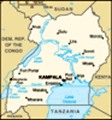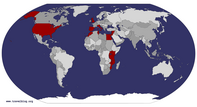Advertisement
Published: February 1st 2008
For the long ride north to Gulu - a rough five-hour haul that we oddly start at the height of Kampala rush hour - it’s clear that at least one road was overlooked during the build-up to Chogm. Bumpy, craterous, littered with debris, it’s a jarring introduction to the country that exists past the outskirts of Kampala. If I’d been impressed by the smooth ride into the country just a few days ago, I’m quickly coming to realize why Ugandan transport is so notorious. The tarmac is broken and buckled; cars swerve from side to side, dodging massive rocks, preferring the smooth grooves worn into the road’s shoulder to the road itself. Trucks with cargo precariously perched on top groan uphill, their flatbeds piled with sugarcane or spare tires or cattle with great pronged horns rocking from side to side. There are lorries weighted with giant sacks of charcoal, a few boys lazing on top and kicking their bare feet in the air. Motorbikes zip past, boxes lashed to the back, old women in square-shouldered dresses riding side-saddle. One man putters past with a goat strapped to the seat - its hind legs bound and bucking - and a pair of
chickens tightly grasped in his hand.
There are buses, too - a frightful convoy barreling down the road, their windows dusty, their tires smoking and spraying gravel into the air. Harried faces peek back at us, a brief, terrified exchange as we hurtle toward our separate fates. This road is enough to make you find God, or at least send out a desperate search party for Him. We pass one bus idling by the side of the road, smoke billowing from the rear, and another laying on its side, surrounded by broken glass. Further on we see a bus hidden in a clump of tall grass. I imagine the fearful moment as it broke from the road, hell-bent on disaster, the seconds ticking toward eternity before it came to a terrible stop against the base of a tree. Later we watch another struggling to negotiate a battered stretch of road, veering onto the shoulder and pitching far to the side before righting itself, headlights flickering, prepared for whatever perils lie ahead.
I’d planned to leave Kampala on the early-morning Post bus - described to me as “the least dangerous” of Uganda’s perilous bus options - but was
dissuaded by Borja, a tall, lanky Spaniard who was himself heading north for some volunteer work. He’d been hanging around the bar at Backpackers these past few days, chain-smoking, fidgeting nervously, watching Uganda-league soccer on the tiny bar TV. A photographer from Jerez, he’s on his way to Gulu to run a photography workshop for local children. Through an odd coincidence, his contact in the north is an American named Tiffany - a
CouchSurfer I’d written to just a few days ago, looking for a place to stay. He offers me a lift, and I tag along the next day for the long ride north, packed into the back of a Land Rover alongside a few screeching kids, a box of Christmas cards, and a Russell Hobbs espresso machine.
The truck is owned by Invisible Children, a Gulu-based NGO that works with youths affected by the two-decade-long civil war in the north. For the past two years it’s rebuilt schools and lives in the war-ravaged region, giving hope to kids who spent much of the past two decades living in fear and, often, on the run. It was the Lord’s Resistance Army - the north’s notorious rebel group -
that pioneered the practice of kidnapping children and recruiting them as soldiers. Local families, anxious about the safety of their children after dark, would send them on “night commutes,” with hundreds of kids carrying sleeping mats to any crowded public place where guards could keep a watchful eye over them. Pictures show them curled into tiny apostrophes in the basements of police stations and churches and schools, their frail bodies pressed shoulder to shoulder - a communion of fear and sorrow.
It’s been a decade since the kidnappings reached their peak, but even now, with peace talks between rebel leaders, the Ugandan government and neighboring countries inching forward, the stalemate in place appears to be a wary one. One of the LRA’s main conditions for peace is an agreement that Joseph Kony and other rebel leaders won’t be prosecuted for war crimes by an international tribunal in the Hague - a demand that’s justifiably met with fierce resistance around the bargaining table. Many Ugandans in the north look toward the future with uncertainty. Jolly, Invisible Children’s country director, describes the group’s reluctance to build new schools where old ones were razed just a few years ago, guarded against the
prospects of failed peace talks. And in the refugee camps that orbit the city, packed with displaced persons who fled their homes during the war, few people have been willing to return to the lives they left - unsure of what they’ll find, and anxious that the year-long truce won’t last.
It’s a slow, painstaking process trying to bring hope back to this shattered region. Aid workers pour into Gulu, settling into gated, guarded compounds on the city’s outskirts, plowing through the streets in their logo-ed SUVs. Many are flush with funding from international donors; for others, like the African-run HEALS, it’s a constant uphill climb. The group, founded by local Acholis and spearheaded by Invisible’s Jolly, epitomizes all the hopes and struggles of grassroots groups in Africa. Working with area children, HEALS aims to rebuild their young lives through Health, Education, Arts, Literacy & Sports. It’s largely the sort of “play therapy” I’d rolled my eyes at when I first heard about it in Nairobi. But I’ve at least come to realize that there’s something worthwhile in teaching these war-stricken kids how to play.
We visit HEALS one afternoon, in a small compound down one of
the twisting, grass-covered roads on the town’s fringes. Borja’s come to drop off his bags: it’s through HEALS that he’ll be running his photography school, and the group is letting him stay in a spare bedroom - partly out of gratitude, partly to offset the costs of the extortionate import taxes he had to pay to get all that equipment into the country. The office is a threadbare room with a couple of desks and a sink in the corner. Pictures from HEALS events are taped to the wall, the bookshelf crammed with binders for the group’s countless projects. Some kids have begun to assemble in the yard. Later in the afternoon, Emmy - an AIDS orphan who’s been adopted by Jolly and her family - will teach his daily breakdancing class, and the kids are practicing their footwork on a plastic sheet spread across the rocky earth. In a room nearby, a young boy is tapping away on a Casio keyboard. He’s leaning over Beethoven’s 9th in an exercise book, playing the same eight bars over and over, frowning with effort.
Close to thirty kids have arrived by the time Emmy begins his lesson. He’s a serious, self-assured
17-year-old, his t-shirt and khaki shorts loosely draped over a slender frame. He assembles them in crooked rows - barefoot boys with fake Nike headbands and Power Ranger t-shirts; girls in plastic Bata sandals and shapeless blouses and dusty skirts. Emmy paces back and forth like a drill sergeant, barking in Acholi, shooting a reproachful stare when a fit of giggles bursts out from the back. He walks them through a few steps, swinging his arms, pivoting his hips, skating back on the soles of his feet. In clumsy unison, thirty bodies follow suit - an unruly flailing of gangly arms and spindly legs, Emmy watching gravely and nodding his head in 4/4 time.
Finally they run through the whole routine from start to finish. Some of the dancers struggle to control their laughter; others look so pained by each pop and lock, you’d think the fate of Uganda hinged on their performance. Clouds of dust swirl around their heels. Chickens cluck outside the compound’s walls. Emmy claps and nods his approval, and when they’re finished there’s a spontaneous burst of applause. There’s joy and relief on their faces - a sense that whatever just passed between them, it
was something good. They laugh and high-five and chase each other around the yard in agitated circles. Afterward they perform some traditional Acholi songs and dances, stomping their feet and shaking their shoulders and wiggling their hips while their voices carry the high notes into the air. It’s a frenzied, inspired, carnal performance. Sweat beads on their foreheads and chins; they revolve around each other, thrusting their heads and rocking their backsides. The guys’ voices rumble in low, rhythmic baritones. Drums beat wildly. Borja circles with his camera, zooming and clicking away, and later that night we’ll look over his pictures, agreeing that it was a very good day.
Advertisement
Tot: 0.07s; Tpl: 0.013s; cc: 7; qc: 24; dbt: 0.0338s; 1; m:domysql w:travelblog (10.17.0.13); sld: 1;
; mem: 1.1mb












